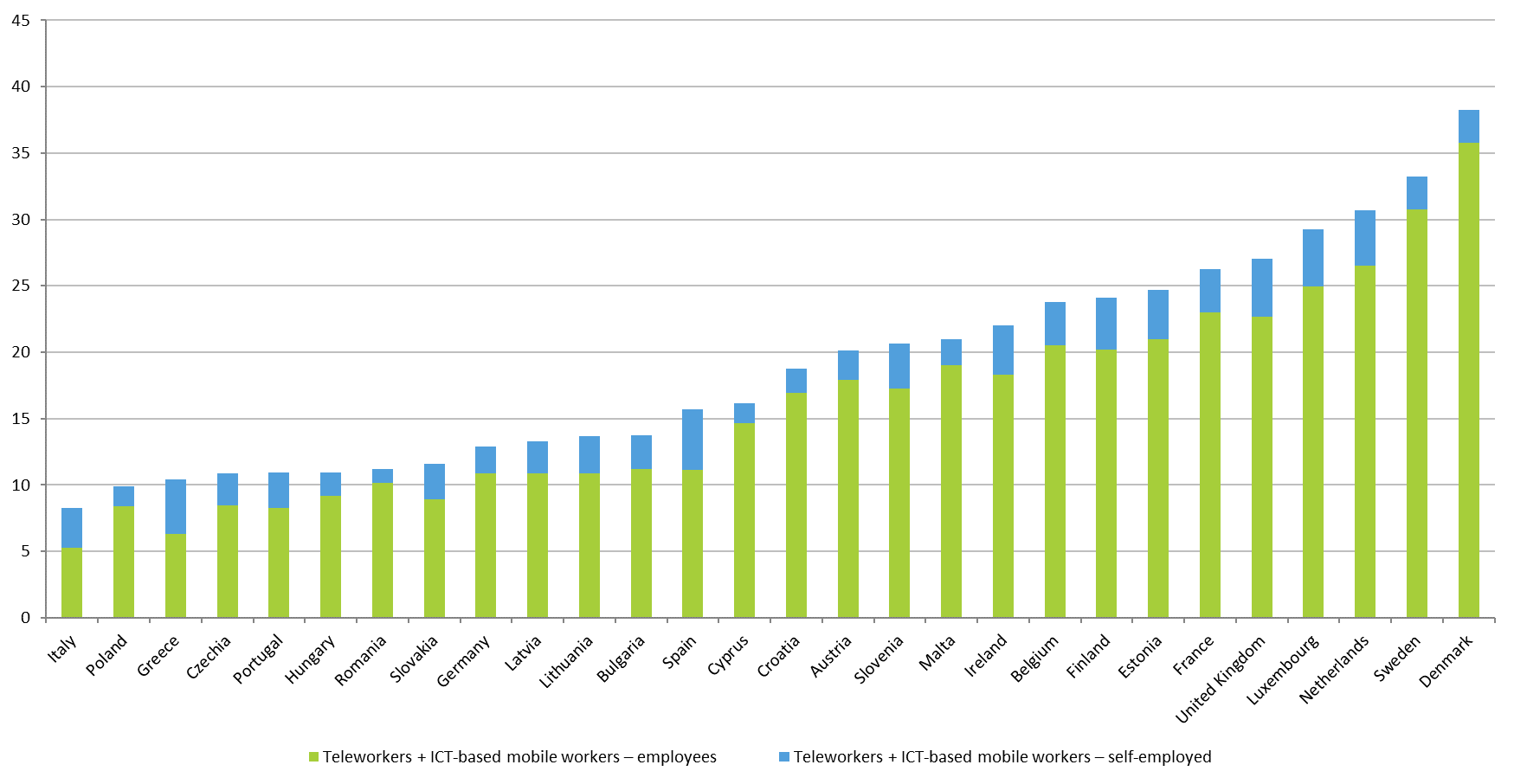[Join the authors of this blog Irene Mandl and Oscar Vargas Llave for the webinar Flexible working in the digital age – Is everyone a winner? on 13 June 2019.]
ICT-based flexibility in Europe
Flexible working time and flexible places of work are nothing new. But advances in information and communications technology (ICT) have added a whole new dimension to flexibility, allowing workers to virtually connect with colleagues, clients and business partners anytime and anywhere. ICT has opened the door to new ways of organising work, resulting in much more flexibility around when and where tasks are performed. In short, we are shifting from a regular, bureaucratic and ‘factory-based’ working time pattern towards a more flexible model of work.
In the EU, around one-fifth of workers telework from home or engage in what we call ICT-based mobile work, meaning they work, either occasionally or regularly, from somewhere other than a main place of work, like a train or a coffee shop, heavily depending on mobile devices like a laptop or iPad. There is some diversity in the percentages by country – as the chart below illustrates, figures range from 8% in Italy to 33% in Denmark.
Percentage of workers doing telework and ICT-based mobile work, by employment status
Source: European Working Conditions Survey 2015
The reason for this diversity across Europe is a combination of factors, such as a country’s affinity for technology; the availability and quality of its technological infrastructure; management culture and the drive for higher productivity within companies; and employees’ needs for spatial and temporal flexibility to balance work demands with family commitments and other personal responsibilities.
Happy flexibility?
Increased flexibility is generally perceived as a positive feature of job quality. It gives workers more autonomy and control, allowing them to combine work with a variety of life situations and make choices according to their individual preferences. This potentially boosts productivity while enabling a better work–life balance. From a labour market perspective, ICT-supported flexibility offers better employment opportunities for some groups of workers, like those with disabilities, illnesses or care responsibilities, whom a standard work schedule doesn’t suit, or those living in remote areas with few local employers.
However, this type of working also has downsides. Paradoxically, the higher level of autonomy quite often results in people working longer hours or at higher intensity, because they use the flexibility to supplement rather than replace office time. Or they feel pressured to do more work in exchange for the flexibility provided by the employer or because of excessive workload. Sometimes, this situation can be a result of work organisation, but it can also be due to the worker’s desire to prove their performance is unaffected or even enhanced by the location. As a result, teleworkers and ICT-based mobile workers who work more intensively are more likely to report high levels of stress, anxiety, sleeping disorders, headaches and eye strain.
A new phenomenon is now being observed among these workers: virtual presenteeism. Presenteeism is when employees go to work in spite of being sick. Again, it is nothing new and is often related to the employee’s fear of negative consequences if they miss work. But now ICT is facilitating people to work from home when they’re not feeling well, which is likely to impair their performance. What such behaviour means for the recovery process and long-term health has not been determined.
Bigger challenge for self-employed
One section of the ‘flexible workforce’ – in terms of having a high level of autonomy – likely to embrace flexibility-enabling ICT are the self-employed. General economic developments, notably the ongoing shift to a service economy, are a factor. Additionally, there is some anecdotal evidence that for at least some types of freelancers, like consultants or those in the creative industries, clients value their ability to adapt their working hours and to operate from different locations.
So far, little research has been carried out on ICT-supported flexible working among the self-employed. But the available findings indicate that this form of work is generally positive for their work activity. It supports their entrepreneurial initiatives and fosters their professional prospects. It also helps to overcome professional isolation by keeping them in touch virtually with colleagues. However, findings also show that this group presents higher risks of lack of rest periods in comparison with other self-employed. As they are not covered by labour law, which at least in some countries is already tackling the ‘right to disconnect’, it is particularly important for them to find individual ways to disconnect, balancing the business need with their own health and well-being.



